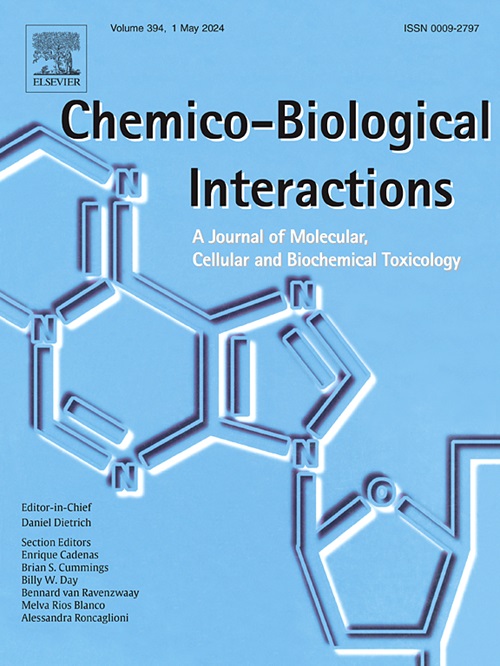第一间膜-原型精神活性细缕生物碱的毒性预测:使用多方面的计算机方法预测对临床和法医毒理学重要的关键毒理学终点。
IF 5.4
2区 医学
Q1 BIOCHEMISTRY & MOLECULAR BIOLOGY
引用次数: 0
摘要
本研究旨在使用多种计算工具对间膜进行全面的计算机毒理学评估,以评估其安全性,并与临床和法医毒理学相关。采用一套定性和定量预测平台:ADMETlab 3.0、admetSAR 3.0、Deep-PK、ProTox 3.0、STopTox、TEST 5.1.2、ACD/Percepta和VEGA QSAR 1.2.3,分析了一个典型的间膜smile表示。这些工具用于预测急性毒性(LD50)、器官特异性毒性、遗传毒性、心脏毒性(hERG抑制)和皮肤/眼睛刺激。据预测,Mesembrine具有中度急性毒性,大鼠口服LD50值估计在340至370 mg/kg之间,符合GHS第4类。器官特异性毒性模型表明,对呼吸和肾脏系统产生不良影响的可能性很高,而对肝毒性的预测则存在矛盾。hERG通道抑制的低至中等概率表明,浓度升高时可能存在心脏毒性。遗传毒性(艾姆斯试验)预测一致地将间膜置于非诱变类别。然而,对皮肤和眼部刺激的预测是不确定的,不同平台的结果不同。这项研究提出了第一个整合的硅毒理学档案的膜。虽然它支持中度毒性分类,但结果强调了对呼吸,肾脏和潜在心脏毒性的具体关注。鉴于该化合物的精神活性特性和日益增长的商业可用性,进一步的体外和体内研究对于全面的风险评估和监管指导至关重要,特别是在法医毒理学背景下。本文章由计算机程序翻译,如有差异,请以英文原文为准。

First toxicity profile prediction for mesembrine – archetypal psychoactive Sceletium alkaloid: prediction of key toxicological endpoints important to clinical and forensic toxicology using a multi-faceted in silico approach
This study aims to perform a comprehensive in silico toxicological assessment of mesembrine using multiple computational tools to evaluate its safety profile, with relevance for both clinical and forensic toxicology. A canonical SMILES representation of mesembrine was analyzed using a suite of qualitative and quantitative prediction platforms: ADMETlab 3.0, admetSAR 3.0, Deep-PK, ProTox 3.0, STopTox, TEST 5.1.2, ACD/Percepta, and VEGA QSAR 1.2.3. These tools were used to predict acute toxicity (LD50), organ-specific toxicity, genotoxicity, cardiotoxicity (hERG inhibition), and skin/eye irritation. Mesembrine was predicted to have moderate acute toxicity, with estimated oral LD50 values in rats ranging between 340 and 370 mg/kg, corresponding to GHS Category 4. Organ-specific toxicity models indicated a high probability of adverse effects on the respiratory and renal systems, with conflicting predictions for hepatotoxicity. A low-to-moderate probability of hERG channel inhibition suggests potential cardiotoxicity at elevated concentrations. Genotoxicity (Ames test) predictions consistently placed mesembrine in the non-mutagenic category. However, predictions for dermal and ocular irritation were inconclusive, with results varying between platforms. This study presents the first integrative in silico toxicological profile of mesembrine. While it supports a moderate toxicity classification, the results highlight specific concerns regarding respiratory, renal, and potential cardiac toxicity. Given the compound's psychoactive properties and growing commercial availability, further in vitro and in vivo studies are essential for comprehensive risk assessment and regulatory guidance, particularly in forensic toxicology contexts.
求助全文
通过发布文献求助,成功后即可免费获取论文全文。
去求助
来源期刊
CiteScore
7.70
自引率
3.90%
发文量
410
审稿时长
36 days
期刊介绍:
Chemico-Biological Interactions publishes research reports and review articles that examine the molecular, cellular, and/or biochemical basis of toxicologically relevant outcomes. Special emphasis is placed on toxicological mechanisms associated with interactions between chemicals and biological systems. Outcomes may include all traditional endpoints caused by synthetic or naturally occurring chemicals, both in vivo and in vitro. Endpoints of interest include, but are not limited to carcinogenesis, mutagenesis, respiratory toxicology, neurotoxicology, reproductive and developmental toxicology, and immunotoxicology.

 求助内容:
求助内容: 应助结果提醒方式:
应助结果提醒方式:


